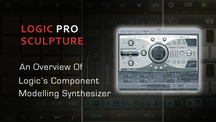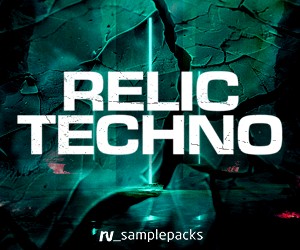Sculpture is a unique instrument to Logic in that it is something called a ‘component modeling synth’. Where Logic's other synths are the more standard FM and additive synth types, Sculpture tries to make a virtual model of an actual acoustic instrument which mimics that instrument's physical properties. In this and a following tutorial, we will look at how this unusual synth operates and how we can manipulate its parameters to create a realistic electric bass sound.
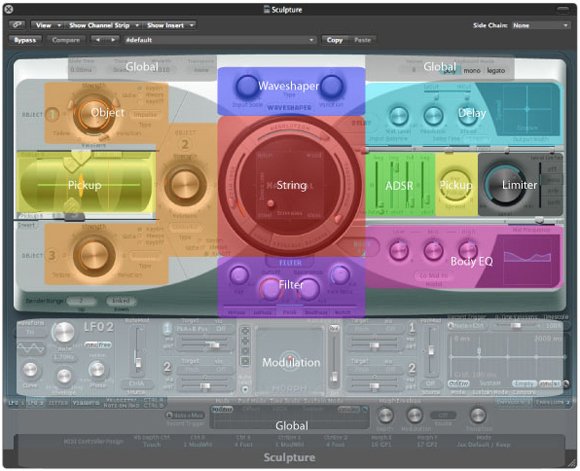
Overview
First, some basic background information is a good place to start as Sculpture has some rather unique parameters that require some explanation. In order of signal flow, they are:
- String Section: Here you can set the properties of the string you will be modeling. The central pad allows for material selection (steel, nylon, etc.), while the surrounding sliders from left to right control media loss (emulates string dampening from the outside environment), resolution (determines maximum number of harmonics) and tension modulation (sets a momentary detuning of the string).
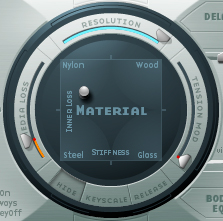
Detail of Sculpture’s string section.
- Object Section: Here you can set up to three parameters to affect the string. At least one object must be activated for any sound to occur as, just like in real life, a string that is not affected by an outside force does not make any sound. The main portion of this section is the drop down menu that allows for 15 different types of either excitation, disturbing or dampening to be performed on the string. The large knobs set the strength of the action being performed, the timber slider changes between dull and bright sounds and the variation slider, which is another timbre parameter, whose effect changes based on the object type selected in the drop down menu (a comprehensive list can be found in the Logic Studio Instruments manual, pg. 334-337). Finally, the gate mode buttons select when the action is performed on the string.
- Pickup Section: This section emulates the pickups of an electric guitar or bass. The three large sliders control where the respective objects effect the string. The two pickup position sliders determine where the virtual pickups are placed along the string. The invert button inverts the phase of pickup B which can either thicken or thin the overall sound depending on the relationship with pickup A. Additionally, there are two controls to the right of the ADSR under the ‘Spread’ heading. The key spread sets the amount of panning by MIDI note number (i.e. the further up or down the keyboard you play, the further left or right the sound will be panned), and the pickup spread does what it says and spreads the pickups across the stereo field.
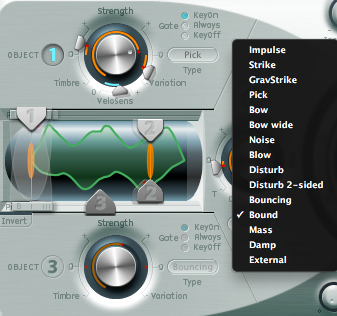
Detail of the object and pickup sections.
- ADSR Section: This section operates as one would expect; with standard ADSR controls. However, the attack is somewhat unique in how it works. There are two sliders for attack: the lower slider determines the attack at maximum velocity while the lower determines the attack at minimum velocity. Furthermore, when both are set to 0 and a note is triggered while the string is still vibrating, it is reset. If anything other than 0 is set and a note is triggered while the string is vibrating, the occurring vibration acts on the new note as well which creates a unique and more organic sound
- Filter section: This is the most standard section of Sculpture and acts as one would expect.
- Waveshape section: This is a rather standard waveshape distortion unit. The controls are fairly self explanatory as well.
- Delay section: This is fairly basic as well. However the groove pad in the upper left is a pretty unique feature and is an intuitive way of creating stereo swing/groove times by simply moving the central puck around the XY axis.
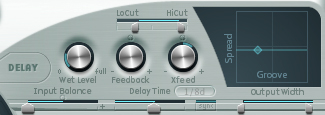
Detail of Sculpture’s delay.
- Body EQ Section: This area of Sculpture can act as a basic 3-band EQ or as a complex frequency spectrum shaper. The rounded rectangular button just below the knobs is a disclosure menu which allows you to choose between the basic EQ and a number of real instrument body EQ models. Depending on what you select, the knobs will have different functions. In basic EQ mode, the knobs are straight forward. In body EQ mode, the knobs and slider change and shift various characteristics of the model. The best way to learn how these act is to simply play around with them.
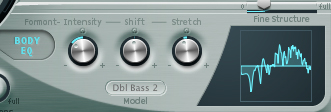
Detail of the body EQ.

